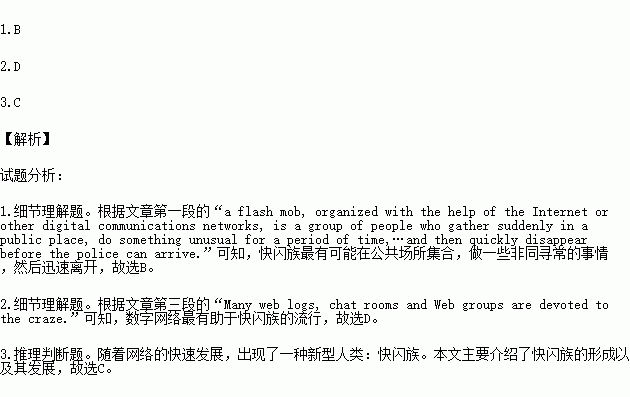题目内容
阅读理解。
Don’t be surprised if you see a group of people dancing or shouting on the square. They are a flash mob (快闪族). Confused by their name? Actually, a flash mob, organized with the help of the Internet or other digital communications networks, is a group of people who gather suddenly in a public place, do something unusual for a period of time, such as exchanging books, coming together to look at the sky, waving their hands and shouting something at the top of their lungs for 30 seconds, and then quickly disappear before the police can arrive.
Bill Wasik, senior editor of Harper’s Magazine, organized the first flash mob in Manhattan in May 2003 and the first successful flash mob gathered on June 3, 2003 at Macy’s department store involving 100 people gathering on Macy’s Department Store. Following this, about 200 people flooded the lobby of the Hyatt hotel, applauding in one voice for fifteen seconds, and next participants pretending to be tourists on a trip invaded a shoe shop in Soho. A later mob saw hundreds of people in Central Park making bird noises.
Wasik claimed that he created flash mobs as a social experiment designed to tease hipsters (追逐时尚的人), and highlight the cultural atmosphere of agreement and of being part of “the next big thing”. Many web logs, chat rooms and Web groups are devoted to the craze. Though flash mobs were originally regarded as useless, the concept has already developed for the benefit of political and social events. Flash mobbing takes advantage of the efficiency of communicating information on Websites and by email, and protesters can similarly use the “on and off” concept to be involved in political events. Such flash mob gatherings can sometimes shock or frighten people who are not aware of what is taking place. They also have enormous economic potential, such as using flash mobs to advertise a product.
The flash mob is now becoming more and more popular. People use it to do many things. For example, in 2009, hundreds of Michael Jackson’s fans took part in a flash mob to remember him, gathering outside the railway station in Liverpool, singing and dancing Michael’s famous song, beat it together. In another example, some people took part in a flash mob to warn people against negative words. Flash mobs give people from all walks of life an opportunity to come together to create a memory.
1.A flash mob is most likely to .
A. give out leaflets of a brand bicycle to the passers-by
B. gather in public places performing and leave quickly
C. plan to go mountaineering on the first day of Horse Year
D. sit for days in front of the city hall for higher wages
2.According to the passage, what contribute(s) most to the popularity of the flash mob?
A. Harper’s Magazine. B. The government.
C. Political events. D. Digital networks.
3.The purpose of the writing is .
A. to amuse and interest
B. to argue and advise
C. to describe and introduce
D. to question and comment
 开心练习课课练与单元检测系列答案
开心练习课课练与单元检测系列答案 开心试卷期末冲刺100分系列答案
开心试卷期末冲刺100分系列答案
